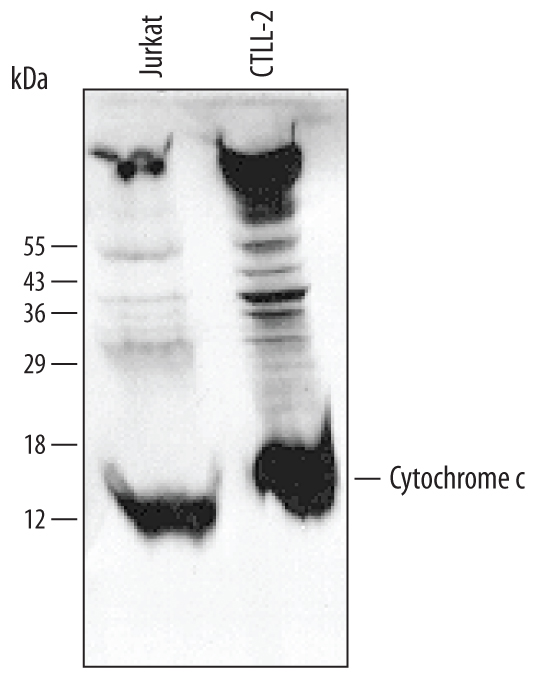Human/Mouse/Rat Cytochrome c Antibody Summary
Applications
Please Note: Optimal dilutions should be determined by each laboratory for each application. General Protocols are available in the Technical Information section on our website.
Scientific Data
 View Larger
View Larger
Detection of Human and Mouse Cytochrome c by Western Blot. Western blot shows lysates of Jurkat human acute T cell leukemia cell line and CTLL-2 mouse cytotoxic T cell line. PVDF membrane was probed with 0.5 µg/mL of Mouse Anti-Human/Mouse/Rat Cytochrome c Monoclonal Antibody (Catalog # MAB897) followed by HRP-conjugated Anti-Mouse IgG Secondary Antibody (Catalog # HAF007). A specific band was detected for Cytochrome c at approximately 12 kDa (as indicated). This experiment was conducted under reducing conditions and using Immunoblot Buffer Group 4.
 View Larger
View Larger
Detection of Human Cytochrome c by Simple WesternTM. Simple Western lane view shows lysates of human heart tissue, loaded at 0.2 mg/mL. A specific band was detected for Cytochrome c at approximately 23 kDa (as indicated) using 2.5 µg/mL of Mouse Anti-Human/Mouse/Rat Cytochrome c Monoclonal Antibody (Catalog # MAB897). This experiment was conducted under reducing conditions and using the 12-230 kDa separation system.
Reconstitution Calculator
Preparation and Storage
- 12 months from date of receipt, -20 to -70 °C as supplied.
- 1 month, 2 to 8 °C under sterile conditions after reconstitution.
- 6 months, -20 to -70 °C under sterile conditions after reconstitution.
Background: Cytochrome c
Cytochrome c is a mitochondrial electron transport protein that functions in oxidative phosphorylation. Release of Cytochrome c into the cytosol is an early step in apoptotic cell death.
Product Datasheets
Citations for Human/Mouse/Rat Cytochrome c Antibody
R&D Systems personnel manually curate a database that contains references using R&D Systems products. The data collected includes not only links to publications in PubMed, but also provides information about sample types, species, and experimental conditions.
6
Citations: Showing 1 - 6
Filter your results:
Filter by:
-
Lipid storage droplet protein 5 reduces sodium palmitate?induced lipotoxicity in human normal liver cells by regulating lipid metabolism?related factors
Authors: X Ma, F Cheng, K Yuan, K Jiang, T Zhu
Mol Med Rep, 2019-06-06;20(2):879-886.
Species: Human
Sample Types: Cell Lysates
Applications: Western Blot -
Silencing of heat shock protein 27 increases the radiosensitivity of non?small cell lung carcinoma cells
Authors: L Xu, X Lin, Y Zheng, H Zhou
Mol Med Rep, 2019-05-22;0(0):.
Species: Human
Sample Types: Cell Lysates
Applications: Western Blot -
Loss of the novel mitochondrial protein FAM210B promotes metastasis via PDK4-dependent metabolic reprogramming
Authors: S Sun, J Liu, M Zhao, Y Han, P Chen, Q Mo, B Wang, G Chen, Y Fang, Y Tian, J Zhou, D Ma, Q Gao, P Wu
Cell Death Dis, 2017-06-08;8(6):e2870.
Species: Human
Sample Types: Cell Lysates
Applications: Western Blot -
Pre-exposure of Mycobacterium tuberculosis-infected macrophages to crystalline silica impairs control of bacterial growth by deregulating the balance between apoptosis and necrosis.
Authors: Chavez-Galan L, Ramon-Luing L, Torre-Bouscoulet L, Perez-Padilla R, Sada-Ovalle I
PLoS ONE, 2013-11-22;8(11):e80971.
Species: Human
Sample Types: Cell Lysates
Applications: Western Blot -
HA14-1, a small molecule inhibitor of Bcl-2, bypasses chemoresistance in leukaemia cells.
Authors: Oliver L, Mahe B, Gréé R, Vallette FM, Juin P
Leuk. Res., 2007-01-16;31(6):859-63.
Species: Human
Sample Types: Cell Lysates
Applications: Western Blot -
Synergistic induction of apoptosis in breast cancer cells by cotreatment with butyrate and TNF-alpha, TRAIL, or anti-Fas agonist antibody involves enhancement of death receptors' signaling and requires P21(waf1).
Authors: Chopin V, Slomianny C, Hondermarck H, Le Bourhis X
Exp. Cell Res., 2004-08-15;298(2):560-73.
Species: Human
Sample Types: Cell Lysates
Applications: Western Blot
FAQs
No product specific FAQs exist for this product, however you may
View all Antibody FAQsReviews for Human/Mouse/Rat Cytochrome c Antibody
Average Rating: 5 (Based on 1 Review)
Have you used Human/Mouse/Rat Cytochrome c Antibody?
Submit a review and receive an Amazon gift card.
$25/€18/£15/$25CAN/¥75 Yuan/¥2500 Yen for a review with an image
$10/€7/£6/$10 CAD/¥70 Yuan/¥1110 Yen for a review without an image
Filter by:
Antibody Dilution 1:100. We used this on mouse meniscus lysates. Antibody was incubated overnight and developed with ECL kit. It worked very well and we would use it again.




